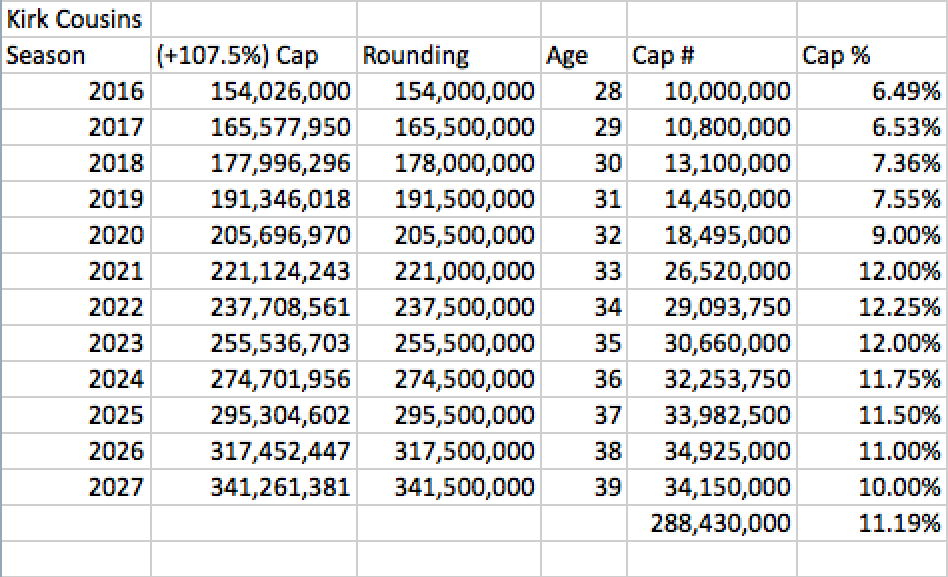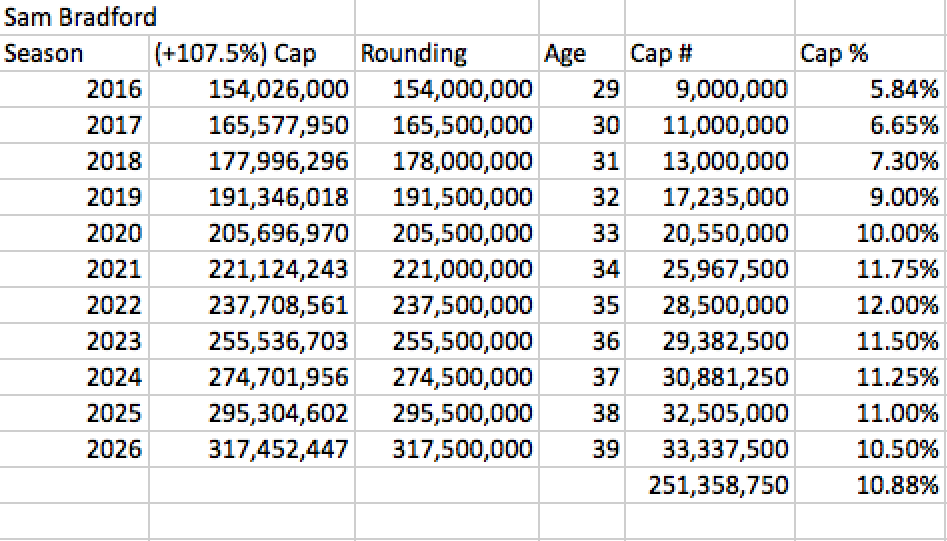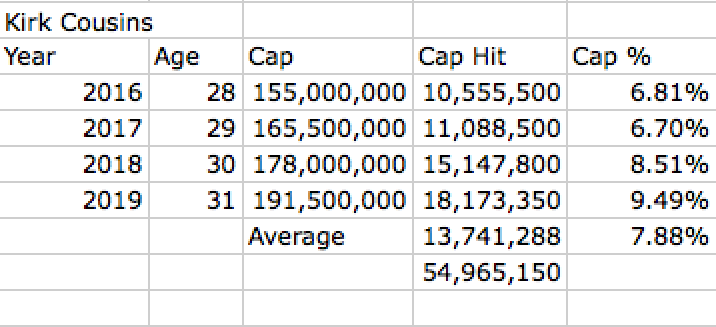Some may think that I’m crazy for believing quarterbacks, especially ones like Kirk Cousins, Brock Osweiler and Sam Bradford, should try to get contracts that pay them handsomely, but are also team friendly. Many believe they should try to get everything they can, rather than settle for reasonable deals with their current teams.
The salary cap is about to increase at a rate that hasn’t been seen before in the NFL,; the history of the salary cap combined with Roger Goodell’s projection of $25 billion in revenues by 2027 show us that, as I wrote here last summer. If I’m any of these quarterbacks, sure I want to be paid in the short-term, but I want to ensure I’m in a situation where I’m going to be a high earner into the future. Any short-term gain pales in comparison to where future earnings will be, especially considering the length of a quarterback’s career in comparison to the rest of the league. The length of a QB’s career, the size of their earnings in comparison to the rest of the league, their impact on their team, but also their cap hit’s impact on their team’s cap situation are all major factors that make this market slightly different than every other one.
The Browns could be in the position to make a move for Osweiler or Bradford and either might end up costing them about what a first round signal caller would have cost them and allow them to use that #2 pick on someone who they felt more comfortable with. The top three quarterbacks in this draft–Carson Wentz from North Dakota State, Jared Goff from Cal and Paxton Lynch from Memphis– all have question marks , so the Browns might be seriously interested in Osweiler or Bradford enough to pay them more than what I would project, but Osweiler couldn’t be in a better position to start his career.
That leaves Bradford as the only one left on the table of these three. While the Browns have some pieces and Hue Jackson is one of the most highly regarded offensive minds in the league, which could interest Bradford, I think they’d pass on Bradford and use the #2 pick on Wentz, plus maybe a 4th or 5th rounder on Kevin Hogan out of Stanford to give them a potential project as I think he’s been one of the most underrated players in college football these last few years and highly accurate with a 67.8% completion percentage as a senior. For Bradford, I’d rather stay with the weapons I have in Philadelphia with a similar West Coast offense anyway. There’s just not enough there in Cleveland, where QBs have gone to die for almost 2 decades now, for me to think they can recruit one of those two away from situations that are much less risky for the two signal callers.
Below are just some rough projections for the total career earnings for the three quarterbacks. For Cousins and Osweiler, I used the projections from my Kirk Cousins and Broncos articles: so Cousins at four years, $48.35 million and Osweiler at three years, $27 million. I gave Bradford a short, three year, $33 million contract at $11 million a year as I feel like he’s the middle ground between Cousins and Osweiler, less of a ceiling than Cousins, more proven than Osweiler. It’s my belief that no player should make above about 12% of the cap, so I gave these guys conservative estimates for their contracts that are coming after the one they’re currently negotiating.
Cousins would be averaging 11.19% per year in cap hits, while Osweiler would be 10.90%. This isn’t because I’m projecting one will be better than the other, but Cousins’ has three less years to earn now that he’s entering his 28-year-old season and Osweiler is entering his 25-year-old season. With less time to earn big money, Cousins has to be more concerned with getting it in less time, while Osweiler can take a really team-based viewpoint and create a situation similar to Brady in New England, but for different reasons.
I have notes for an article outline I started last summer about Gisele might be the biggest economic force in the quarterback market, and I’ll have to take those out for the podcast to accompany this episode, as her wealth has provided Brady with the opportunity to sign the most team-friendly contract in the NFL. His cap hits in 2015 and 2016 are between 9-10% of the salary cap, which is about what Andy Dalton costs instead of the 12-14% of the cap that Peyton Manning and Aaron Rodgers make. This is a huge deal for the Patriots as that allows them to sign one or two more of those important short-term veterans they always find around 1-2% of the cap. I reference it often, but my Manning/Brady article last year illustrates the impact of Brady’s lower cap hits on their team’s success.
Before I go any further, here are the projected future lifetime earnings for these three players if they can make it through this next contract and onto the next as the unquestioned face of the franchise:
Figure 1: Kirk Cousins:
Figure 2: Brock Osweiler
Figure 3: Sam Bradford
I didn’t want to muddy the figures above, but Mike Tanier’s article breaking down all of the potential scenarios and suitors in this quarterback market, along with this from Jason LaCanfora reminded me that I have to be slightly more conscious of the market forces in the quarterback market. While I’m a firm believer that teams have to be more rational with their QB spending, if a player like Cousins were to get to free agency next year after a solid 2016, the Redskins could run the risk of him really getting towards $20-22 million a year on the open market. This makes me think that after they franchise tag him and negotiate into the summer, they’ll end up in a middle group where Cousins will just be paid almost exactly what Dalton received, just with the inflation of the salary cap factored in. To do this is easy, I just took the first four years from Dalton’s contract and spread them from 2016 to 2019 for Cousins:
Figure 4: Cousins with Dalton’s Cap Hits
With the increases in the salary cap from 2014 to 2016, using the exact same cap percentages and the same projections for future salary caps, Cousins would make $54,965,150 compared to Dalton’s $47,459,063. Cousins in 2016 would cost the same as Dalton in 2014 for their teams, but because of the inflation, Cousins would make $7,506,087 more over the course of the four years. This might end up being the middle ground they agree on. I would think this is a fair contract for the Redskins and Cousins as well, both sides could be happy. One could argue that you’d want Cousins more than Dalton as Cousins’ 2015 was more efficient than anything Dalton had done up to that point. Although Cousins has a very small sample size compared to a few years of success for Dalton at the point of his signing, another $6-7 million more than what I had projected over four years is a price the Redskins would have to be willing to pay. Just like you don’t want him playing at about 12% of the cap in 2016 as the Redskins need a ton of help elsewhere, there’s no way you want to risk Cousins hitting free agency in 2017.
Bringing it back to the market, the figures show that the big, more appropriate goal for all three of these players isn’t this contract, but the third contract. They can only command so much right now because all three of them have question marks. Cousins only blew us away for 10 games, which is a very small sample size. Osweiler looked like he could make the Broncos formula work, but he didn’t do anything to push him into a long-term, top of the market contract conversation. Bradford showed he could run Chip Kelly’s offense with accuracy once he settled in, which might make him a candidate for San Francisco if they decide to cut Kaepernick and eat his $7.4 million in dead money, or he might be the perfect guy for Doug Pederson as his offense throws the kind of shorter passing game that plays to Bradford’s strengths.
For the sake of all three of these player’s teams, neither of them can afford to franchise them as they’re just not worth 12% of the cap, nor will their teams have the space to do that and make the appropriate moves in free agency. It’s very unlikely that either of these three play themselves into the $20-22 million range in one season on the franchise tag anyway.
For the sake of all three of these players though, this contract isn’t going to be their lottery ticket, the; it will be their ticket to give them a chance at the next contract which can be the real jackpot.
Tweet me: @ZackMooreNFL
I’ll be discussing this more on Episode #6 of The Zack Moore Show, which will be up on iTunes and Soundcloud within the next two days. Please subscribe and give it five stars if you enjoy as that helps with the ratings on iTunes!
I’m also in Indianapolis until Friday morning if you’re in town for the combine and want to learn more about the Caponomics research and Caponomics: Moneyball Thinking for the NFL, which will be coming out this year. You can always e-mail me at Caponomics@gmail.com.



